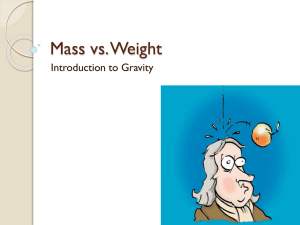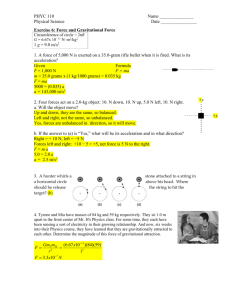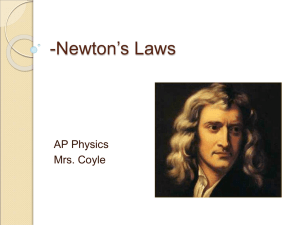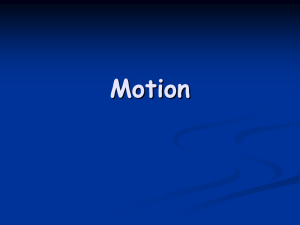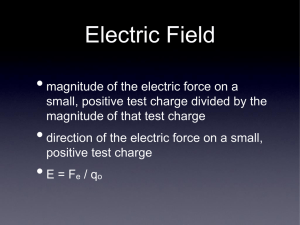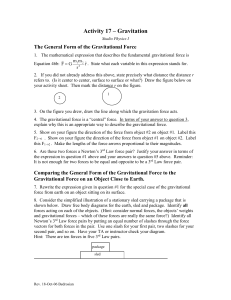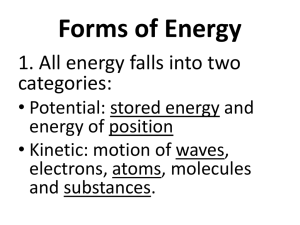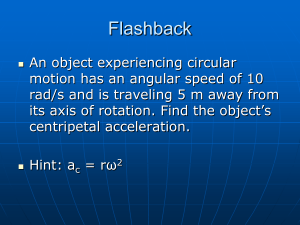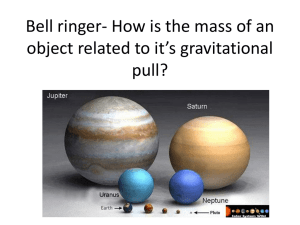File - SPHS Devil Physics
advertisement
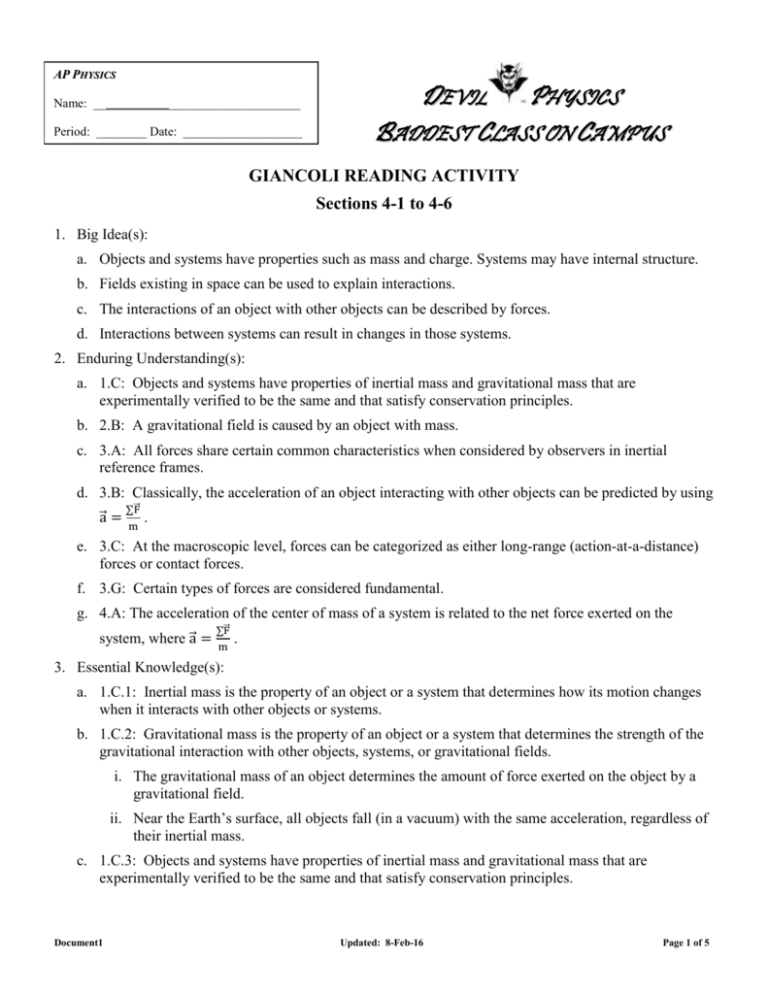
AP PHYSICS Name: _________________________________ Period: ________ Date: ___________________ DEVIL PHYSICS BADDEST CLASS ON CAMPUS GIANCOLI READING ACTIVITY Sections 4-1 to 4-6 1. Big Idea(s): a. Objects and systems have properties such as mass and charge. Systems may have internal structure. b. Fields existing in space can be used to explain interactions. c. The interactions of an object with other objects can be described by forces. d. Interactions between systems can result in changes in those systems. 2. Enduring Understanding(s): a. 1.C: Objects and systems have properties of inertial mass and gravitational mass that are experimentally verified to be the same and that satisfy conservation principles. b. 2.B: A gravitational field is caused by an object with mass. c. 3.A: All forces share certain common characteristics when considered by observers in inertial reference frames. d. 3.B: Classically, the acceleration of an object interacting with other objects can be predicted by using a⃗ = ⃗ ∑F m . e. 3.C: At the macroscopic level, forces can be categorized as either long-range (action-at-a-distance) forces or contact forces. f. 3.G: Certain types of forces are considered fundamental. g. 4.A: The acceleration of the center of mass of a system is related to the net force exerted on the system, where a⃗ = ⃗ ∑F m . 3. Essential Knowledge(s): a. 1.C.1: Inertial mass is the property of an object or a system that determines how its motion changes when it interacts with other objects or systems. b. 1.C.2: Gravitational mass is the property of an object or a system that determines the strength of the gravitational interaction with other objects, systems, or gravitational fields. i. The gravitational mass of an object determines the amount of force exerted on the object by a gravitational field. ii. Near the Earth’s surface, all objects fall (in a vacuum) with the same acceleration, regardless of their inertial mass. c. 1.C.3: Objects and systems have properties of inertial mass and gravitational mass that are experimentally verified to be the same and that satisfy conservation principles. Document1 Updated: 8-Feb-16 Page 1 of 5 d. 2.B.1: A gravitational field ⃗g at the location of an object with mass m causes a gravitational force of magnitude mg to be exerted on the object in the direction of the field. i. On the Earth, this gravitational force is called weight. ii. The gravitational field at a point in space is measured by dividing the gravitational force exerted by the field on a test object at that point by the mass of the test object and has the same direction as the force. iii. If the gravitational force is the only force exerted on the object, the observed free-fall acceleration of the object (in meters per second squared) is numerically equal to the magnitude of the gravitational field (in newtons/kilogram) at that location. e. 3.A.1: An observer in a particular reference frame can describe the motion of an object using such quantities as position, displacement, distance, velocity, speed, and acceleration. i. Displacement, velocity, and acceleration are all vector quantities. ii. Displacement is change in position. Velocity is the rate of change of position with time. Acceleration is the rate of change of velocity with time. Changes in each property are expressed by subtracting initial values from final values. iii. A choice of reference frame determines the direction and the magnitude of each of these quantities. f. Forces are described by vectors. i. Forces are detected by their influence on the motion of an object. ii. Forces have magnitude and direction. g. 3.A.3: A force exerted on an object is always due to the interaction of that object with another object. i. An object cannot exert a force on itself. ii. Even though an object is at rest, there may be forces exerted on that object by other objects. iii. The acceleration of an object, but not necessarily its velocity, is always in the direction of the net force exerted on the object by other objects. h. 3.A.4: If one object exerts a force on a second object, the second object always exerts a force of equal magnitude on the first object in the opposite direction. i. 3.B.1: If an object of interest interacts with several other objects, the net force is the vector sum of the individual forces. j. 3.C.4: Contact forces result from the interaction of one object touching another object and they arise from interatomic electric forces. These forces include tension, friction, normal, spring (Physics 1), and buoyant (Physics 2). k. 3.G.1: Gravitational forces are exerted at all scales and dominate at the largest distance and mass scales. l. 4.A.3: Forces that systems exert on each other are due to interactions between objects in the systems. If the interacting objects are parts of the same system, there will be no change in the center-of-mass velocity of that system. 4. Learning Objective(s): a. (1.C.1.1): The student is able to design an experiment for collecting data to determine the relationship between the net force exerted on an object, its inertial mass, and its acceleration. Document1 Updated: 8-Feb-16 Page 2 of 5 b. (1.C.3.1): The student is able to design a plan for collecting data to measure gravitational mass and to measure inertial mass, and to distinguish between the two experiments. c. (2.B.1.1): The student is able to apply ⃗F = mg ⃗ to calculate the gravitational force on an object with mass m in a gravitational field of strength g in the context of the effects of a net force on objects and systems. d. (3.A.1.1): The student is able to express the motion of an object using narrative, mathematical, and graphical representations. e. (3.A.1.2): The student is able to design an experimental investigation of the motion of an object. f. (3.A.1.3): The student is able to analyze experimental data describing the motion of an object and is able to express the results of the analysis using narrative, mathematical, and graphical representations. g. (3.A.2.1): The student is able to represent forces in diagrams or mathematically using appropriately labeled vectors with magnitude, direction, and units during the analysis of a situation. h. (3.A.3.1): The student is able to analyze a scenario and make claims (develop arguments, justify assertions) about the forces exerted on an object by other objects for different types of forces or components of forces. i. (3.A.3.2): The student is able to challenge a claim that an object can exert a force on itself. j. (3.A.3.3): The student is able to describe a force as an interaction between two objects and identify both objects for any force. k. (3.A.4.1): The student is able to construct explanations of physical situations involving the interaction of bodies using Newton’s third law and the representation of action-reaction pairs of forces. l. (3.A.4.2): The student is able to use Newton’s third law to make claims and predictions about the action-reaction pairs of forces when two objects interact. m. (3.B.1.1): The student is able to predict the motion of an object subject to forces exerted by several objects using an application of Newton’s second law in a variety of physical situations with acceleration in one dimension. n. (3.B.1.2): The student is able to design a plan to collect and analyze data for motion (static, constant, or accelerating) from force measurements and carry out an analysis to determine the relationship between the net force and the vector sum of the individual forces. o. (3.B.1.4): The student is able to predict the motion of an object subject to forces exerted by several objects using an application of Newton’s second law in a variety of physical situations. p. (3.C.4.1): The student is able to make claims about various contact forces between objects based on the microscopic cause of those forces. q. (3.C.4.2): The student is able to explain contact forces (tension, friction, normal, buoyant, spring) as arising from interatomic electric forces and that they therefore have certain directions. r. (3.G.1.1): The student is able to articulate situations when the gravitational force is the dominant force and when the electromagnetic, weak, and strong forces can be ignored. s. (3.G.1.2): The student is able to connect the strength of the gravitational force between two objects to the spatial scale of the situation and the masses of the objects involved and compare that strength to other types of forces. Document1 Updated: 8-Feb-16 Page 3 of 5 t. (4.A.3.1): The student is able to apply Newton’s second law to systems to calculate the change in the center-of-mass velocity when an external force is exerted on the system. u. (4.A.3.2): The student is able to use visual or mathematical representations of the forces between objects in a system to predict whether or not there will be a change in the center-of-mass velocity of that system. 5. Read sections 4-1 to 4-6 in your textbook. 6. Write a definition for each of the terms listed below (include equations where appropriate): a. Dynamics b. Force c. Force of Gravity or Gravitational Force d. Newton’s First Law of Motion e. Inertia f. Law of Inertia g. Inertial reference frames h. Noninertial reference frames i. Mass (as used in this context) j. Weight k. Newton’s Second Law of Motion l. Net force m. Force (pg 76 definition) Document1 Updated: 8-Feb-16 Page 4 of 5 n. Newton o. Newton’s Third Law of Motion p. Force of Gravity or Gravitational Force (pg 81 definition) q. Weight (pg 87 definition) r. Contact force s. Normal force 7. Answers may be typed or neatly printed. Drawings may be freehand, but try to make use of the ‘Shapes’ or ‘Insert Clipart” functions of MS Word. Practice use of the MS Equations function - it will pay great dividends in the long run. If you submit this assignment electronically, the filename must be in the following format, “LastnameFirstinitialPerXReadActX-X”. Document1 Updated: 8-Feb-16 Page 5 of 5
